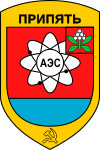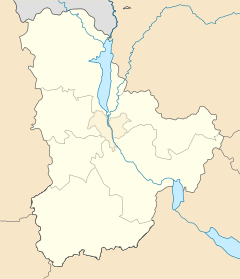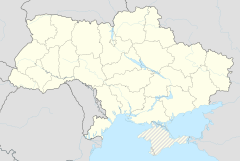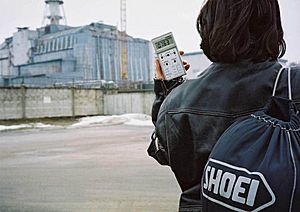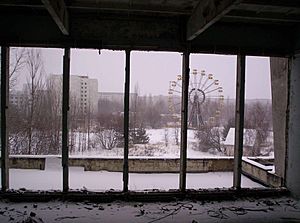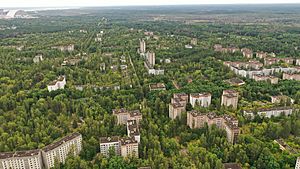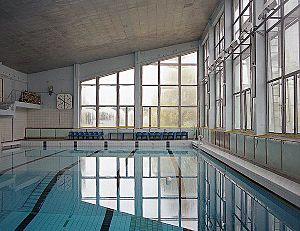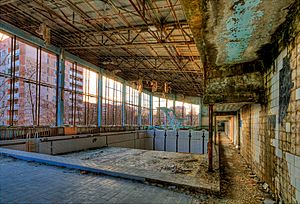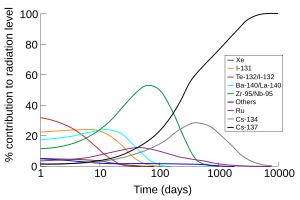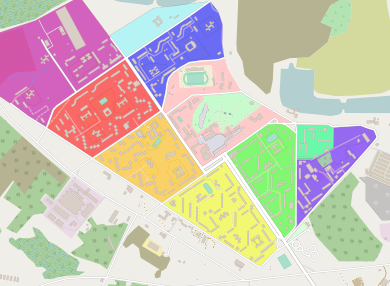Pripyat facts for kids
Quick facts for kids
Pripyat
Прип'ять
|
||
|---|---|---|
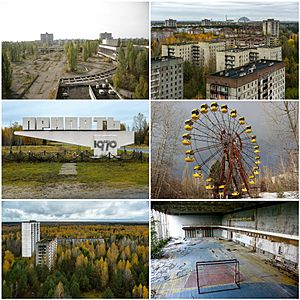
Clockwise from top-left:
|
||
|
||
| Country | ||
| Oblast | Kyiv Oblast | |
| Raion |
|
|
| Founded | 4 February 1970 | |
| City rights | 1979 | |
| Area | ||
| • Total | 8 km2 (3 sq mi) | |
| Elevation | 111 m (364 ft) | |
| Population | ||
| • Total | 0 | |
| (c. 49,000 in 1986) | ||
| Time zone | UTC+02:00 (EET) | |
| • Summer (DST) | UTC+03:00 (EEST) | |
| Postal code |
None (formerly 01196)
|
|
| Area code(s) | +380 4499 | |
Pripyat (pronounced PREE-pyət or PRIP-yət) is a city in northern Ukraine. It's mostly an abandoned city today, located close to the border with Belarus. The city gets its name from the nearby Pripyat River.
Pripyat was started on February 4, 1970. It was built as a special "atomgrad" city, which means it was a closed city in the Soviet Union made to house workers from the nearby Chernobyl Nuclear Power Plant. Pripyat officially became a city in 1979. Before the Chernobyl disaster in 1986, about 49,360 people lived there. They were all moved out on April 27, 1986, just one day after the accident.
Even though it's abandoned, Pripyat is still an important city in the Kyiv Oblast region of Ukraine. It's looked after by the State Emergency Service of Ukraine, which manages the whole Chernobyl exclusion zone. After the 1986 disaster, all the people from Pripyat moved to a new city called Slavutych, which was built just for them.
Contents
History of Pripyat
Building a New City
Before the Chernobyl disaster, Pripyat was not a secret city like some military towns. The Soviet Union believed that nuclear power stations were very safe. They even had a popular saying, "peaceful atom," to show how nuclear power was used for good things.
The original plan was to build the power plant only about 25 kilometers (15 miles) from Kyiv, the capital city. But scientists and other groups worried that this was too close to such a big city. So, the power plant and Pripyat were built about 100 kilometers (60 miles) away from Kyiv instead.
{{wide image|Pripyat Panorama.JPG|880px|A panorama of Pripyat in summer. The Chernobyl power plant is visible in the distance.]]
Life After the Chernobyl Disaster
In 1986, after the disaster, the city of Slavutych was built to replace Pripyat. It became the second-largest city for power plant workers and scientists in the region.
Many famous photos of Pripyat show the abandoned Ferris wheel in the Pripyat amusement park. This park was supposed to open just five days after the disaster, for May Day celebrations. The Azure Swimming Pool and Avanhard Stadium are also popular places that people visit.
On February 4, 2020, some people who used to live in Pripyat came back to the abandoned city. They were celebrating the 50th anniversary of Pripyat being founded. This was the first time many former residents had returned since the city was left empty in 1986.
In 2022, during the Russian invasion of Ukraine, Russian forces took control of Pripyat for a short time. After some fighting, they left the area on March 31. Ukrainian troops then took control of Pripyat again on April 3.
Life in Pripyat: Before 1986
Here are some facts about Pripyat from January 1, 1986, just before the disaster:
- The city had a population of 49,400 people. The average age of residents was about 26 years old.
- There were 160 apartment buildings with 13,414 apartments.
- For education, Pripyat had 15 kindergartens and elementary schools for almost 5,000 children. There were also five secondary schools for over 6,700 students.
- Healthcare included one hospital that could hold 410 patients, and three clinics.
- For shopping and food, there were 25 stores and malls, and 27 cafes and restaurants.
- The city had a cultural center called the Palace of Culture Energetik, a cinema, and an arts school.
- Sports facilities included 10 gyms, three indoor swimming pools, and two stadiums.
- Pripyat also had a park, 35 playgrounds, and many trees and rose plants.
- There were four factories and the large Chernobyl Nuclear Power Plant with four reactors.
- The city had a railway station, 167 city buses, and a large car park for the power plant workers.
Safety in Pripyat Today
Many people wonder if it's safe to visit Pripyat and the areas around it. The "Zone of Alienation," which is the restricted area around Chernobyl, is now considered relatively safe for visitors. Several Ukrainian companies offer guided tours of the area.
In most parts of Pripyat, the level of radiation is not very high. It usually doesn't go above 1 microsievert per hour. A microsievert is a very small unit used to measure radiation.
Transport in Pripyat
The city had a train station called Yaniv station. It was an important stop on the railway line and was located between Pripyat and the village of Yaniv.
Today, an electric train station called Semikhody, built in 1988, is the only working station near Pripyat. It connects the area to Slavutych, the city where many former Chernobyl workers now live.
Notable People from Pripyat
- Markiyan Kamysh (born 1988) – a writer and explorer of Chernobyl.
- Vitali Klitschko (born 1971) – a politician, currently the mayor of Kyiv, and a former professional boxer.
- Wladimir Klitschko (born 1976) – also a former professional boxer.
- Alexander Sirota (born 1976) – a photographer, journalist, and filmmaker.
- Lyubov Sirota (born 1956) – a poet, writer, and journalist.
Images for kids
-
Pripyat city limit sign with a radiation dosimeter
See also
 In Spanish: Prípiat para niños
In Spanish: Prípiat para niños


